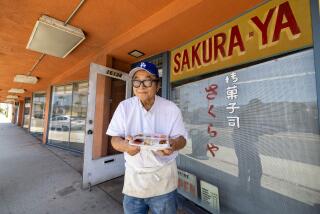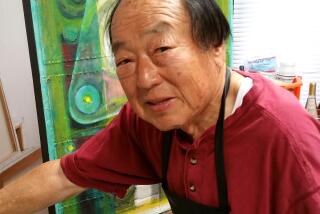Vacation Memories : The Accidental Tutor Plays a Big Role in Japan
Next time you get the urge to strike out on your own when traveling abroad, heed the call.
Not being tied to a tour group frees one to discover hidden corners of the city, and to have personal experiences that can be richly rewarding and provide insights otherwise impossible to achieve.
That’s exactly what happened to my wife and me on a spring Saturday in Tokyo last May. I had no appointments, so I decided we should get out of the city. Because it’s close by and has a variety of cultural attractions, we headed for Kamakura.
It’s a town 30 miles east of Tokyo on the Miura Peninsula. In the early 12th-Century, Yoritomo Minamoto, first of the shogun, established his capital in Kamakura.
Today it’s renowned as the site of the famous Daibutsu or Great Buddha statue, as well as several major Zen temples, lots of shopping and good restaurants.
Getting there was easy. We caught the Yokosuka Line train of Japan Railways at Shimbashi Station, and in 55 minutes were there.
We had just handed over our train tickets to the ticket-taker at the station’s exit when three young Japanese converged on us.
Now, if you’ve traveled much abroad you’re aware of the hustlers, self-appointed tour guides and pushy taxi drivers who descend on foreign visitors at airports and train terminals.
These people are invariably bad news, offering overpriced or unwanted services . . . or worse. That sort of thing doesn’t happen in Japan, though, so the appearance of the trio was somewhat disturbing. But only for a moment.
One young man introduced himself and quickly explained. He and his friends were members of the English Conversation Club from Senshu University in Kanagawa Prefecture. That’s about an hour and a half by train from Tokyo; few foreigners live or work there.
Once a month, students come to Kamakura in the hope of meeting English-speaking tourists to practice their English. The best place to encounter tourists is the railroad station, so they had positioned themselves at the exit.
It’s not all that unusual to meet young people in the Far East seeking to practice English on native speakers, such as American tourists. But this trio was different.
In exchange for the opportunity to use their English, they offered to be our guides to the sights of Kamakura, without charge.
Instead of imposing on our time and patience, they proposed something of a trade of services.
I wondered how many American college students would give up their Saturday to travel three hours round trip at their own expense in the hope of improving their foreign-language ability. I think I know the answer.
With the use of a guidebook it’s possible to tour Kamakura without a personal escort. But Hideki Sakashita, 20; Misaki Jodai, 18, and Naohiro Kuba, 18, were such delights that we readily agreed to have them join us.
For the next few hours we wandered the grounds of the Kotokuin Temple where the Daibutsu is, then walked over to the Hase Kannon Temple.
It quickly became apparent how little we know about the Shinto and Buddhist religions, and the way Japanese relate to both.
Shrines and Temples
Our student friends answered our questions--about the shrines and temples and such things as the role of religion in everyday Japanese life. But we also talked about their career goals and ambitions. It didn’t surprise me that all three were in the school of business.
Throughout the afternoon they were open and personable but clearly intent on keeping their end of our pact.
Although I offered to do so, the young people paid for their own bus fares and entrance fees to the shrines and fully intended to pay for their own meals when we took a break from our sightseeing to rest and have lunch.
However, I insisted on treating for the kontatsu , a deep dish of boiled rice topped with a fried egg and deep-fried breaded pork cutlet served with shredded cabbage and washed down by innumerable cups of green tea.
Over lunch as we talked I would occasionally correct some error in their use of English grammar, even diagramming on a paper napkin the construction of a typical sentence--subject, verb, predicate. (In Japanese, the verb comes at the end of the sentence, there are no plurals and personal pronouns are rarely used.)
After we left the tiny restaurant we returned to the railroad station and walked beneath a large red torii gate to reach the Komatchidori-- a long gravel lane lined with cherry trees and azaleas. It leads to the spectacular Tsurugaoka Hachimangu Shrine, built in the late 12th Century by the first Kamakura shogun.
By then it was getting late; we had to return to Tokyo. Our casual tour-group-cum-English-conver-sation-class swung around back to the train station. The trio of students thanked us profusely for our company, but the session was not quite over.
Sakashita-san, as group leader and upperclassman, whipped out a form. Even in such an informal encounter, the Japanese penchant for documentation prevailed.
We were invited to comment on the university club’s conversational English program. There was also something of a receipt, to verify the fact that these three did indeed spend the afternoon with us.
I dutifully filled out and signed the sheet, bowed and we hurried to catch our train.
As is often the case with such encounters, I suspect we learned more about our students and their culture than they did of our language.
More to Read
Sign up for The Wild
We’ll help you find the best places to hike, bike and run, as well as the perfect silent spots for meditation and yoga.
You may occasionally receive promotional content from the Los Angeles Times.






